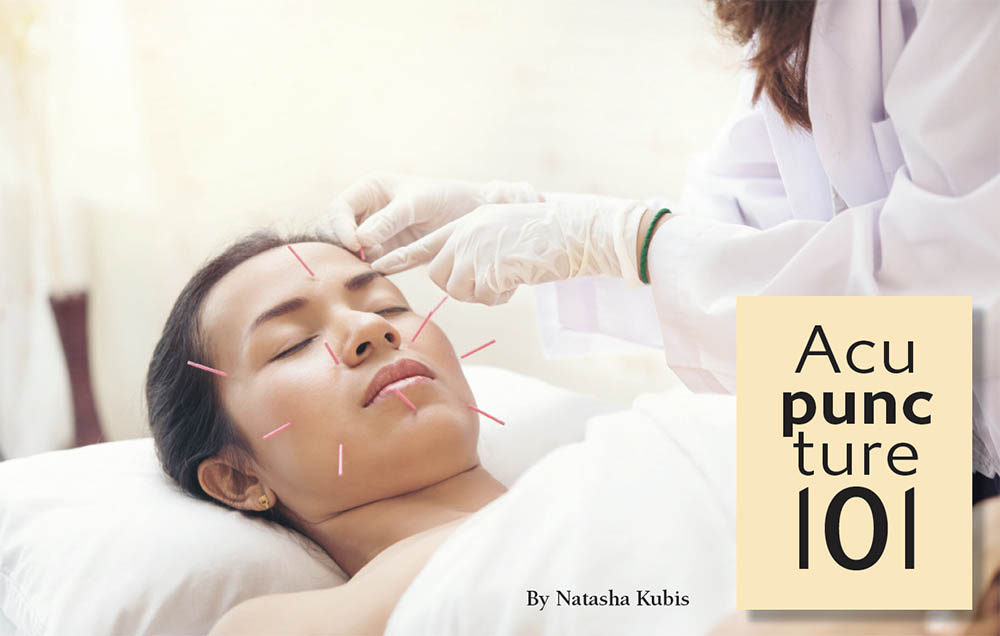By Natasha Kubis
Acupuncture has been practiced in China for over 3,000 years and involves the insertion of thin, sterile needles into the skin at specific points in order to treat a wide range of disorders. The World Health Organization recognizes acupuncture as an effective option for chronic and acute pain management, hormone and pregnancy related issues, allergies, digestive issues, hypertension, anxiety, and depression. Clinical trials have also shown positive outcomes when used to treat the side effects of chemotherapy drugs.
The mechanisms of this ancient tradition are not widely understood in our culture, and when things are not understood, they can quickly be disregarded as hocus pocus. This is largely because acupuncture has been studied and communicated through its ancient and classic framework, which is poetic and metaphorical in nature. As westerners, it can be hard for us to wrap our minds around the obscure concepts of “qi” and “yin and yang,” but if we take the poetry of the classic texts and redefine it through the lens of modern biomedical concepts, it can be a bit easier to consider for a viable treatment option for disease.
How did acupuncture gain popularity in the U.S.?
Acupuncture has been practiced in the US since the 1800’s; primarily amongst Asian communities, but in 1972, a New York Times columnist, named James Reston, underwent an emergency appendectomy while visiting China with the Nixon administration. He later wrote about his positive acupuncture experience in the New York Times and this was the dawn of mainstream acupuncture.
What are the benefits of acupuncture?
Acupuncture can provide drug-free pain relief, which is particularly important during our current opiate crisis. It stimulates the body’s natural ability to suppress pain without the over-dependency of painkillers. Studies have found acupuncture points at sites of high-density neuro-vascular structures. When we stimulate those areas, we are promoting secretion of naturally occurring neurotransmitters, like endorphins, which help minimize pain.
Is it painful?
This is the most common question I receive from potential clients. Modern acupuncture needles are about the size of a cat whisker and the treatment should be relatively painless. To give you perspective, you can fit 40 acupuncture needles into the tip of a syringe. The sensation levels of acupuncture depend greatly on the practitioner, the style of acupuncture, and the types of needles being used. Primitive societies in China used stone needles (resembling an arrow head) to stimulate acupuncture points. Needle materials evolved from stone, then bronze, and eventually to gold and silver. Today, stainless steel is used to make needles and a plastic guide tube allows for quick and painless insertion.
How does it work?
Classical Perspective
In traditional Chinese medicine, the body and its functions are seen as a delicate balance of two opposing and inseparable forces: yin and yang. Yin represents the cold, slow, or passive principle, while yang represents the hot, excited, or active principle. Perfect health is achieved when the body maintains a balanced state of yin and yang. On the contrary, disease is a result of an imbalance of yin and yang. This imbalance leads to blockage in the flow of qi (energy) along meridian pathways (the channels containing acu-points) and these blockages can lead to physical or emotional illness. The needling of the points where energy pools promotes the movement of stuck energy.
Modern Biomedical Explanation
There are over 2,000 acupuncture points on the body located at nerve endings. Stimulating these points allows different parts of the body to communicate, triggering the release of opioid peptides. Opioids are naturally occurring chemicals in the brain that have an analgesic, or pain-relieving, effect. The release of opioids, such as endorphins, plays a significant role in the reduction of pain. Endorphins help to decrease feelings of pain and increase feelings of euphoria. There has been considerable evidence to support that acupuncture stimulates the central nervous system, and the release of these chemicals, thereby minimizing pain.
Acupuncture may also induce the relaxation of knotted up myofibrils (muscle fibers) within muscular tissue. It also stimulates local blood flow to the tissues by causing a micro trauma to an area of the body, which increases local blood flow to the surrounding area, initiating the healing process.
Does a practitioner of acupuncture need a license?
The National Certification Commission of Acupuncture and Oriental Medicine (NCCAOM) oversees accreditation for acupuncturists across the country. Its database of licensed acupuncturists is a good place to start your search for treatment. Licensed acupuncturists must complete a minimum of three years in a master’s acupuncture program at an accredited school. Each state requires its own license and there are continuing education requirements for recertification on the state and national levels.
Acupuncture is a safe and effective way to manage pain, digestive disorders, allergies, fertility issues, PMS, migraines, anxiety, depression, and more. The treatments aim to rewire the body to function more optimally and are great options to use in collaboration with conventional treatments or for conditions that are not responsive to conventional medicine.
Natasha Kubis is a licensed acupuncturist and certified yoga teacher. For more information, visit acuwellhealth.com

